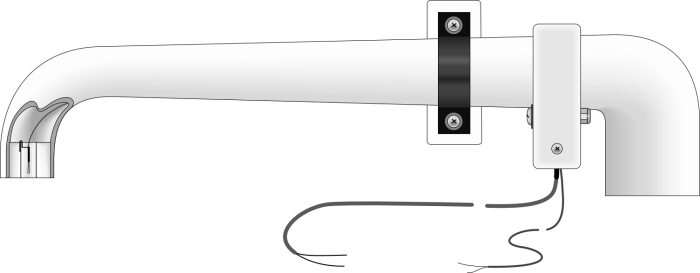
吸引式放射シールド付き細線熱電対






概要
ASPTC-L は、ファン吸引式放射シールドに取り付けられた E 型細線熱電対で構成されており、高精度の気温測定を提供します。1 つの ASPTC を使用して絶対空気温度を測定することも、2 つの ASPTC を使用してデルタ温度測定を行うこともできます。多くの場合、ASPTC はボーエン比システムで TCBR 熱電対の代わりに使用されるか、 TCBR 熱電対に加えて測定されます。
続きを読む利点と特徴
- 正確な気温測定のために細線熱電対を使用
- 吸引式放射シールドを含む
- 高出力ファンが太陽光の影響を軽減
イメージ




詳細
基準温度測定 (通常はデータロガーのワイヤリングパネルで測定) が必要です。基準温度を測定するためのオプションには、次のものがあります:
- CR6、CR800、CR850、CR1000、または CR3000 のワイヤリングパネルに組み込まれたサーミスタ
- CR9000X 測定および制御システムの CR9050 または CR9051E 入力モジュールのワイヤリングパネルに組み込まれた PRT
仕様
| シールド素材 | UV安定化ポリエチレン |
| 大口径 | 5.8 cm (2.3 in.) |
| 小径 | 4.6 cm (1.8 in.) |
| 電源ケーブル直径 | 0.5 cm (0.2 in.) |
| 信号ケーブル直径 | 0.3 cm (0.1 in.) |
| 長さ | 53.3 cm (21 in.) |
| 高さ | 14.7 cm (5.8 in.) |
| 重さ | 0.86 kg (1.9 lb) |
ファン |
|
| 熱電対における空気速度 | 5.5 m/s (@ 12 Vdc) |
| 平均寿命 | 65,000 h (@ 30°C) |
| 消費電流 | 260 mA (@ 12 Vdc) |
| 動作電圧 | 9 ~ 13 Vdc |
| 動作温度範囲 | -10° ~ +70°C |
| 極性保護 | 逆極性保護 |
熱電対 |
|
| タイプ | クロメル - コンスタンタン |
| 一般出力 | 60 μV/°C |
| 正確度 | データロガーのマニュアルの「熱電対測定」セクションを参照してください。 |
| 直径 | 0.0762 mm (0.003 in.) |
互換性
注意: 以下は代表的な互換性情報を示しています。互換性のある製品や互換性のない製品をすべて網羅したリストではありません。
Data Loggers
| 製品 | 互換性 | 注意 |
|---|---|---|
| CR1000 (リタイア) | ||
| CR1000X (リタイア) | ||
| CR3000 (リタイア) | ||
| CR6 | CR6は、CDM-A108またはCDM-A116と組み合わせて使用する場合に互換性があります。 | |
| CR800 (リタイア) | ||
| CR850 (リタイア) |
互換性に関する追加情報
取り付け
電源に関する考慮事項
ASPTC は通常、SP20R、SP50、または SP90 ソーラー パネルで再充電されるユーザー提供のディープ サイクルバッテリで電源供給されます。高電流ドレイン システムの場合、2 つの SP90 ソーラーパネルを使用して 180 W の電力を供給できます。データロガーの充電式バッテリは、AC 電源に接続されている場合にのみ使用できます。システムの電力要件を分析するには、電源のパンフレットまたはアプリケーションノートを参照してください。
ドキュメント
よくある質問
ASPTC-Lに関するよくある質問の数: 5
すべて展開すべて折りたたむ
-
熱電対を吸引するために使用されるファンの最低動作温度が -10°C のためです。
-
いいえ。ASPTC-L は高周波温度変動を測定するために設計されたものではありません。むしろ、平均気温または平均気温勾配を測定するために設計されています。渦共分散法を使用して顕熱流束を見つけるには、音波風速計と FW05 細線熱電対の使用を検討してください。
-
いいえ。日中にファンがオフになっていると、シールドは放射負荷を受け、熱電対はより高い周囲温度を測定します。夜間にファンがオフになっている場合、晴天の条件下では、ASPTC-L シールドは長波放射を放射し、周囲温度よりも低い温度まで冷却されます。その結果、熱電対はより低い周囲温度を測定します。ファンを稼働させて熱電対を吸引すると、周囲温度が測定されていることがわかります。
現場の温度が -10°C 未満になると予想される場合は、FW3、FW1、FW05 などの自然吸引式細線熱電対を、FWTM 細線熱電対マウントおよび細線熱電対用 FWC-L コネクタ ケーブルと組み合わせて使用することを検討してください。
-
-
ステーションの電源は、ASPTC-L ファンの電力需要を満たすように設計してください。データ取得システムには、バッテリ電圧がしきい値を下回った場合に ASPTC-L ファンをオフにする機能が必要です。ただし、晴天時には ASPTC-L シールドが長波放射を放射し、周囲温度よりも低い温度に冷却されるため、通常動作中の夜間はファンをオフにしないでください。ファンを稼働させることで、熱電対は長波放射冷却による温度低下ではなく、周囲温度を測定します。
Privacy Policy Update
We've updated our privacy policy. 詳細はこちら
Cookie Consent
Update your cookie preferences. クッキーの設定を更新する

